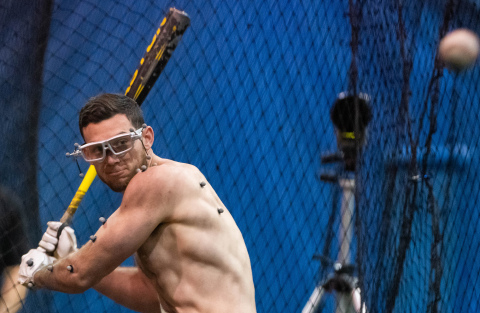GREENVILLE, N.C.--(BUSINESS WIRE)--Researchers at East Carolina University are using motion-capture and eye-tracking technology to understand how baseball players process visual information when batting and turn that into a swing.
Their findings will help players and coaches know what hitters see, how and why they react to it, and, ultimately, turn them into better players. Specifically, they are focusing on what a hitter’s eyes see as a pitch is hurling toward them at upward of 100 miles per hour and how the brain processes that visual information and then instructs the body to swing. It’s the science of hitting.
ECU kinesiology faculty members Nick Murray and Patrick Rider are leading the study. Using motion-capture and eye-tracking technology, they and a group of students tested hitters last fall at Next Level Training Center in Greenville. Test batters from high school to semi-pro levels were fitted with dozens of sensors as well as special goggles to track their eye movements as they watched and then swung at pitches.
“Baseball batting is a cognitively demanding interceptive timing task that requires precision and power,” said Murray, an associate professor and director of the Visual Motor Lab in the College of Health and Human Performance. Previous research has shown expert hitters have a greater ability to spot a moving object, but little research has connected that ability with head position and motor control. “And the fact we’re studying eye-tracking during a realistic at-bat – that is, using a pitcher instead of a machine – makes this study unique.”
“You have a very short time to process what you’re seeing and hit that moving target,” said Rider, a teaching instructor and associate director of the ECU Performance Optimization Lab. He said their findings could lead to new drills or training methods.
Next Level owner Trent Britt agreed. “We’re excited because it’s one more way of looking at things,” said Britt, an ECU graduate who’s spent years as a Major League scout, coach and training expert. He also did the pitching for the study.
“We don’t really get an opportunity to see things from a scientific perspective and what the body is doing. This is one more set of data points,” Britt said. “This is the way sports and baseball are headed. Hitting and anything involving movement is very much an evolving science. It gives us a chance to question are we seeing what we think we’re seeing and help kids get better.”
Lance Martin, director of baseball instruction and baseball programming at Next Level, was one of the test subjects. He was an all-conference player at Mount Olive College.
“Once I started to figure out what the body is doing, in time and in space, I see things in a whole new light,” Martin said of participating in the study. “In turn, that could be used to help the hitter and also help pitchers get an advantage if they can understand that.”
Assisting with the research are doctoral student Chris Curran, who is a former college baseball pitcher; master’s students Ryan Silberg, Andy Jung and Nate Harris; and undergraduate Callie Herman.
In 2017, Murray and kinesiology faculty member Chris Mizelle studied golfers’ eye movements while putting. They’ve presented that research and are in the process of publishing it, Murray said.
Photos and video are available for use at https://news.ecu.edu/2019/03/12/ecu-baseball-study-aims-for-better-hitting/. Please credit ECU News Services.
East Carolina University, or ECU as it’s best known, offers more than 85 bachelor’s, 72 master’s and 19 doctoral degrees to nearly 29,000 students on its Greenville, North Carolina, campus and through an acclaimed online learning program. The university’s school of medicine is recognized nationally for producing primary care physicians, cardiovascular research, advanced robotic surgery as well as obesity and diabetes breakthroughs. ECU also boasts the largest business school enrollment and largest number of new nurses and education professionals produced by a four-year North Carolina university, in addition to the largest studio art program in the state.
Located near Atlantic coast harbors where pirates once roamed, ECU adopted the “Pirates” mascot in 1934 for its athletics program and competes in NCAA Division 1. The university has a globally recognized academic underwater archaeology program and enjoys a supportive relationship with the U.S. military services.

